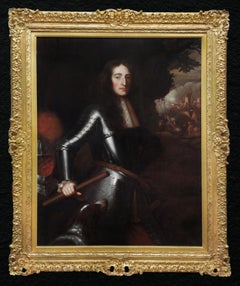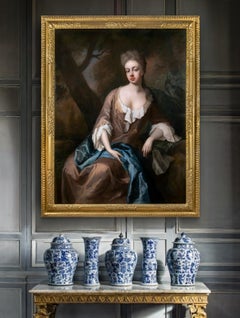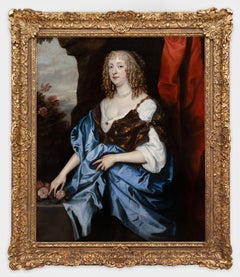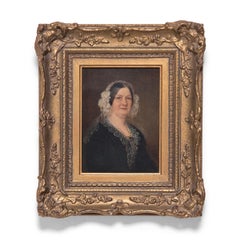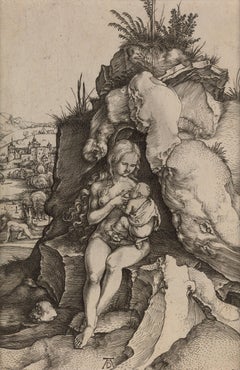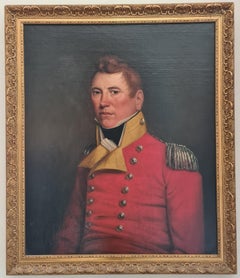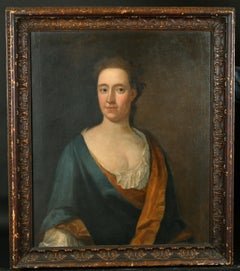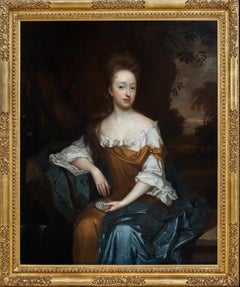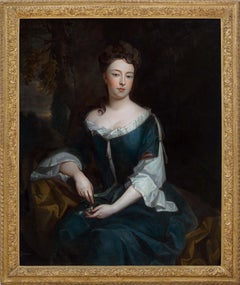This exquisite Grand Manner work, presented by Titan Fine Art, was painted circa 1693 and formed part the Legh family collection at their magnificent home, Adlington Hall. Adlington was built on the site of a Saxon hunting-lodge and became the home of the Legh family during the reign of Edward Il, thus cementing the family's custodianship of Adlington for the next 700 years. Our portrait can be seen hanging in the Drawing Room in a photograph taken by Country Life magazine in 1905 (see photo). Through this portrait, collectors have a chance to acquire an evocative vestige from a glittering aristocratic way of life that is fast disappearing.
It is a good example of portraiture of aristocratic and wealthy women in England during the last quarter of the seventeenth century. Beautifully composed, the sitter is seated in a woodland with a rocky outcrop and a sky just visible through the trees. This arcadian setting draws from the tradition of pastoral literature where life in the country was perceived as peaceful, contemplative, free of worry, and a time to pursue pleasure. By the early seventeenth century, Arcadia was already a popular theme in art and all educated individuals were familiar with Latin and Greek pastoral poetry. As such, the topic was so ingrained in society that, contemporary audiences would have instantly recognised its meaning when viewing this portrait.
The sitter was born Lady Isabella Robartes in 1674. She was the daughter of The Honorable Robert Robartes, Lord Viscount Bodmin (1634-82) who was an English politician and ambassador to Denmark. The Robartes were a Cornish family who resided in Truro for many generations and had acquired great wealth through trading in wool and tin in Tudor times. Robert’s father had suffered considerable losses during the war as his house in Cornwall was occupied by the royalists, his estates were assigned to Sir Richard Grenville, and Robert and his siblings were detained as prisoners with the king. Upon the premature death of Lady Isabella’s father, her mother was later granted the use of the title Countess of Radnor, as she would have been had her husband survived.
On 18 July 1693 Lady Robartes married John Legh of Adlington Hall (1688-1739] who was a colonel of militia, and sheriff of the county in 1705. The couple had three children, Elizabeth (c.1694-burried Westminter Abbey 1734), Lucy Frances Legh (1695-1728), and Charles Legh (1697-1781), Charles succeeded his father in 1739. Charles was a friend of the composer Handel who composed the Musical ‘Blacksmith’ whilst on a visit to Adlington. The sitter died in 1725.
The ancient family of Legh stand high amongst the distinguished lines of Englishmen anciently established in Cheshire which has been called by one old writer “the mother and nurse of gentility”. The Legh family were already an established family in Cheshire having been granted many estates by William the Conqueror after the Norman Conquest in 1066, from John de Legh and Ellen de Corona stem the numerous branches of the family including the Leghs of Lyme and the Leighs of Stoneleigh - both created prominent houses which still exist today. In 1596 Sir Urian Legh joined the earl of Essex in Elizabeth I’s expedition against the Spaniards and having taken a leading part in the siege of Cadiz, received the honour of knighthood on the field.
Adlington in Cheshire is one of that county’s oldest landholdings. Tradition has it that the roof of the famed Great Hall is supported my two pillars hewn from oak trees which still have their roots planted in the Cheshire soil beneath. Set within its sprawling estate, it has a rich history spanning over 700 years and is a reflection of the changing social, architectural, and political landscapes of England.
Adlington is mentioned in the Domesday survey as Edulvinstane, which was owned before the Conquest by the Saxon Earl Edwin and then by Hugh Lupus, Earl of Chester and nephew of William the Conqueror. On Lupus’s death, the manor reverted to the Crown and, early in the 13th century, was granted to the Norman family of de Corona. The last member of the family to own it, having no heir, gave the manor to his sister, Ellen, and her husband, John de Legh and has been the seat of the Legh family since 1315.
The great hall rises uninterruptedly from floor to roof, and has a minstrel's and a lady's gallery opening into it. It is 45’ long, 26’ wide, and about 25’ heigh. The open hammer-beamed roof is richly panelled and each panel is adorned with an armorial shield. The heraldic insignia of the seven Norman earls of Chester, and of their eight barons, are displayed in the first three rows.
During the Civil War the Legh’s, like so many of the Cheshire gentry, embraced the side of Charles, and fought his battles zealously. Adlington being garrisoned for the king, the moat was put to its proper defensive use when the estate was besieged by parliamentary forces, but they held out bravely for a fortnight, but eventually forced to surrender. The toll this period took on the collection is still evident in a double portrait of Thomas Legh the Elder and his wife Anne Gobarte which was defaced by sword-slashes made by billeted parliamentarians – and bullet holes in three or four places in the massive oak door to the Hall.
Six miles nearby is the ‘lordly house of Lyme,” which carries back the mind to the days of chivalry, for it was in recognition of services in the wars with France that the domain was bestowed upon Sir Piers Legh, a younger son of the house of Adlington. This branch of the family was seated there for 600 years until 1946.
Inscribed on the canvas verso: “The Rt Hon. Lady Isabella Legh, Sister to Charles Earl of Radnor, Wife of John Legh of Adlington Esq. Sr G. Kneller”.
The elegant modelling of the hands and arms, the slight turn of the head, and the lock of hair trailing down her neck help to imbue the portrait with a sense of elegance and sophistication. This type of portrait was often used by Kneller and his contemporaries as an archetypal example of what wealthy patrons in England wanted - and these portraits lined the walls of many great halls in stately manors throughout the Britain. From a technical point of view, Kneller’s technique of painting on a blue ground and allowing passages of it to be visible in order to suggest darker flesh tones is evident.
Held in its original gilded period frame.
Sir Godfrey Kneller (1646-1723) was one of the most prominent portrait painters in England at the end of the seventeenth century. He painted seven British monarchs (Charles II, James II, William III, Mary II, Anne, George I and George II) and in 1715 was the first artist to be made a Baronet (the next was John Everett Millais in 1885).
He was born in Germany but trained in Amsterdam and studied in Italy before moving to England in 1676. Towards the end of the century, after the deaths of Peter Lely and John Riley, Kneller became the leading portrait painter in Britain and the court painter to English and British monarchs from Charles II to George I. He dominated English art for more than thirty years. His over 40 "Kit-cat portraits" and the ten "beauties" of the court of William III are most noteworthy. He ran a large, busy and successful studio in London and employed many assistants thereby establishing a routine that enabled a great number of works to be produced. His name became synonymous with British portraiture at the time and he rose to great notoriety; and there were countless other artists that strove to emulate his style. He died of a fever in London in 1723 and a memorial was erected in Westminster Abbey.
In Kneller’s will he left 500 unfinished pictures to his chief assistant Edward Byng (c.1676-1753) who in Kneller’s words had "for many years faithfully served me". Byng lived with him at a house in Great Queen Street. Kneller gave him a pension of £100 a year, and entrusted him to complete these pictures, for which he was to receive the payments for them. Kneller had been paid only by half for these; whether his clients were not as expeditious to pay as they were to sit or whether Kneller’s death came first, the reason being unknown. Byng also inherited drawings in Kneller's studio, many now in the British Museum. He later lived at Potterne, near Devizes, where he died in 1753 and was buried. His brother Robert was also a painter and many works have been jointly attributed to both brothers. According to Edward’s will his estate was divided after his sister Elizabeth's death between his nephew’s William Wray, Robert Bateman Wray and Charles Wray (not, as some have suggested, to Robert Bateman Wray and his sister Mary).
Provenance:
Probably commissioned by the sitter's husband, John Legh, and thence by decent at Adlington Hall for approximately 330 years
Literature:
'Adlington Hall, Cheshire: The Seat of Mr. A.M.R. Legh', Country Life, 29 July 1905, p. 130, 'The Drawing-Room';
Country Life, Nov 28, Dec 5, and Dec 12, 1952;
G. Nares, 'Adlington Hall, Cheshire - III: The home of Mrs. Legh', Country Life, 12 December 1952, p. 1960, fig. 2 'The mid-
Georgian staircase...
